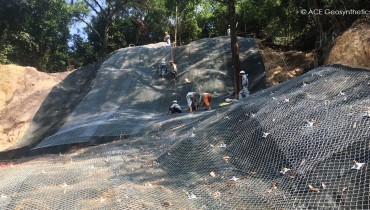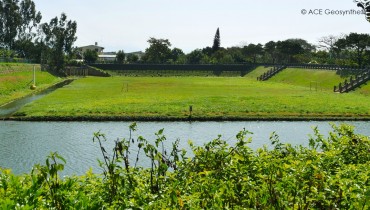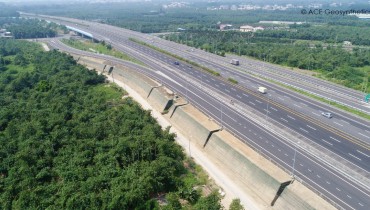News
Special Reports - Successful Cases of ACEGrid® Reinforced Earth Structures with a Galvanized Welded Wire Mesh Facing
Special Reports
Compared with the traditional reinforced concrete retaining wall, ACEGrid® reinforced earth retaining structure has many advantages, for example, reliable safety, seismic resistance, aesthetic landscape, compatibility with the natural environment, energy saving and carbon reduction, simplified technology, and tolerable deformation. It has been widely used in roads, embankments, bridge abutments, soil and water conservation, hillside development, landfills, and various civil constructions. In response to different requirements of projects, the reinforced earth retaining structure has various facing types, including cast-in-place concrete panel, precast concrete panel, segmental block, galvanized welded wire mesh (hereinafter referred to as WWM), and wrap-around hydroseeding.
In this issue, we present two cases of ACEGrid® reinforced earth retaining walls with WWM that our company has completed for nearly 20 years. First, typical construction procedures are described, then the work scope and engineering performances, including design, construction process, and the current situation after almost 20 years of live service, are reported. The result has evidenced the structural safety, durability, and eco-friendly environment of the ACEGrid® reinforced earth wall with WWM. The system’s excellent performance in eco-friendly environment compatibility also has been verified.
A. Construction Process
1. Site preparation/ Foundation Excavation/leveling:
The site preparation and foundation excavation/leveling shall be conducted according to the design drawing. The foundation base shall be thoroughly compacted, and the concrete base, if necessary, can be applied according to the project requirements.
2. Install WWM facings:
Place the first layer of WWM facing on the foundation or concrete base. Lay the erosion control material inside the welded wire mesh and erect the reinforcing braces at the designed intervals.
3. Place ACEGrid®:
After the WWM facing is positioned, place and anchor the ACEGrid®. Install Drainage material: First, place a layer of non-woven fabric on the entire width of ACEGrid®. Then, place a layer of permeable gravel with the drainage pipe, ACEPipeTM, on top of the non-woven fabric. Finally, cover the drainage layer with another layer of non-woven fabric to separate it from the above-backfilled soil.
4. Backfill and Compact:
Backfill designated material behind the WWM facing to the thickness required by the drawing. Compact the backfill using a small compactor thoroughly until it reaches the density specified by the specification.
5. Install Additional Courses:
Repeat steps 2 to 5 to complete the retaining wall to the height required. Tightly fit the upper and lower layers of WWM facings.
6. Hydroseeding:
Hydroseeding the wall's surface, if required by the contract to complete the landscaping.
B. Case Report 1
Reinforced Earth Structure with a Galvanized Welded Wire Mesh Facing at a Downslope of Elementary School ACEGrid®

The site of the reported case is a downslope under the playground of elementary school, and it is also in the immediate proximity of an important local service road in northern Taiwan. The slope collapsed in 2003 after an attack of torrential rain. The slope collapse continued to expand because of enormous rainfall infiltration in the rainy season, which jeopardized the adjacent retaining wall's stability and seriously affected road traffic safety and convenience. The height of the collapsed slope was up to 15m, and the space for rehabilitation was also very limited. Considering the safety of the construction and the local service requirements, the designer vigorously called for a rapid and efficient method for restoration. After comparing multiple schemes, the final decision was to use a reinforced earth structure with a galvanized welded wire mesh facing.

Figure 1. The design scheme of reinforced earth structure with WWM facing in case 1
As shown in Figure 1, the collapsed slope was restored to a multi-staged reinforced earth retaining wall with an averaged slope of 1:05 (V:H) and a total height of 15m using ACEGrid® with galvanized welded wire mesh facing. Because of the frequent heavy rainfall at the site, installation of the drainage system was essential. As the reinforced earth structure was constructed layer by layer, the horizontal ACEPipeTM and the vertical ACEDrainTM were installed to avoid water staying in the reinforced zone, forming seepage pressure and affecting safety. In addition, a geotextile layer was placed behind the WWM facing to prevent the backfill from being eroded by rainwater or runoff. The reported case was completed in 2005, and Figure 2 shows representative photos of the construction.
 |
 |
 |
| Before construction | During Construction | After construction |
Figure 2. The representative photos before, during, and after construction of the reinforced earth structure with WWM facing in case 1
B. Case Report 2
ACEGrid® Reinforced Earth Structure with Galvanized Welded Wire Mesh Facing for Service Road of Second Baoshan Reservoir

To meet the water demand of Hsinchu Science Park, the government built the Second Baoshan Reservoir resulting in the relocation of the No. 45 highway in the reservoir area. The original design was to rearrange the entire highway along the mountain ridge, which thus needs three additional bridges. Because the bridge construction equipment was difficult to get in and out of the site, the designer revised the original design for route and elevations. As shown in Figure 3, the design of the No. 1 bridge was replaced by a height of 25 m ACEGrid® reinforced earth retaining wall with a WWM facing. The second and the third bridge were also revised to be an ACEGrid® reinforced embankment with a WWM facing with a height of 14 m. For the embankment, only two tiers were built because of the limitation of the property line. The width of the offset for each stage was only 1.5 m, and the structure's average slope was 3:1 (V: H). Permeable HDPE ACEPipeTM and gravel were arranged at the bottom of each stage, and they were separated with the above-backfill by a non-woven geotextile layer. The inside of welded wire mesh facing was covered with an erosion control blanket to prevent surface soil from being washed away and also was beneficial for hydroseeding and landscaping. This project was completed in 2003, and Figure 4 shows representative photos of the construction.


Figure 3 The design scheme of reinforced embankment with WWM facing in case 2
 |
 |
 |
| Before construction | During Construction | After construction |
Figure 4 The representative photos before, during, and after the construction of the reinforced embankment with WWM facing in Case 2
C. Current Conditions of the Case
It has been nearly 20 years since the completion of the above two cases. During this period, ACE followed the company's service guidelines by visiting the site for structural safety assessment after every significant natural disaster.
1. Structure Safety
No damage has occurred in either case so far. In case 1, no noticeable deformation appeared on the wall face, the crest, and the corner of the retaining structure. In case 2, traffic volume has been frequent because the site is close to the tourist zone of the reservoir. However, no visible settlement has been observed on the structural surface. The present structural conditions of both cases are sufficient to verify the advantages mentioned above of the ACEGrid® reinforced earth retaining structures with a welded wire mesh facing.
2. Landscape and Ecology
(1) In case 1, after hydroseeding, the ACEGrid® reinforced earth retaining wall with a welded wire mesh facing has matched well with the adjacent natural slope and it was harmonious with the surrounding landscape. Even when the owner carried out weeding and maintenance operations to expose the wall, it showed a better appearance than the gray and monotonous traditional reinforced concrete structure. It also has shown traces of biological activity on the wall, demonstrating the system as an eco-friendly environment. Figure 5 gives the current situation of case 1.
(2) After hydroseeding, the wall can be quickly greened naturally and integrated into the local natural landscape. In case 2, where the site has no human intervention, the flourishing trees are close to the wild forest. Therefore, the construction of the ACEGrid® reinforced structure has entirely avoided the incongruity of traditional reinforced concrete structures. Figure 6 shows the current situation of Case 2.
D. Conclusion
Reinforced earth retaining structure has a wide range of applications. It has different facings and can be used based on project requirements and site conditions. Generally, the reinforced earth retaining structure has the advantages of structural safety, cost saving, less construction time, earthwork balance, and reduced carbon emissions. It is in line with the trend of modern eco-friendly constructions based on safety and ecology. In particular, it is also a substantial contribution to the global goal of Net Zero carbon emissions. The two successful cases of ACEGrid® reinforced earth retaining structures reported herein can serve as the best evidence for the above conclusion.
 |
 |
 |
| Picture 1 | Picture 2 | Picture 3 |
 |
 |
 |
| Picture 1 | Picture 2 | Picture 3 |
Figure 6 Current situation of case 2
UPDATED RESOURCES
Please refer to the latest uploaded information and files on the official website below, and feel free to contact us for further details.
Case Studies
1. Segmental Block Reinforced Structure Applied for the Highway Interchange Project, Israel○ Type: Slope Stabilization, Basal Reinforcement
○ Product: ACEGrid® GG, ACETex® PET
To know our construction supports, visit our website.
To be a member, visit the page to apply for an account.
To learn our exclusive designed services for our online members, please click here.
Similar News

Safeguarding for Shallow Slope Sliding: A Sustainable Slope Stabilization Project
TOP STORY Shallow Landslide Treatment Project, Ba Deo Park, Ha Long City, Vietnam Backgr...

Innovative Flood Management: Detention Pond with Flood Control and Recreational Design
Detention Pond with Reinforced Earth Dike for Fazi River, Taichung, Taiwan Background In recen...

Reinforcement of the Slope at the Entrance Ramp of Interchange on National Freeway, Taiwan
"TOP STORY" In Taiwan, an island nation, freeways play a pivotal role in facilitating...